SKODA SUPERB 2004 1.G / (B5/3U) Owner's Manual
Manufacturer: SKODA, Model Year: 2004, Model line: SUPERB, Model: SKODA SUPERB 2004 1.G / (B5/3U)Pages: 270
Page 101 of 270

Seats and Stowage
100
– The storage compartment is opened by folding it out in the direction of the arrow ⇒fig. 91.
WARNING
The storage compartment must always be closed when driving for
safety reasons.
Stowage compartment below steering wheel
You can use this stowage compartment, for example, for inserting the car
documentation.
Stowage compartment in door panel
WARNING
Use the stowage compartments in the door panels only for small
items which do not project out of the compartment in order to avoid
any interference with the proper operation of the side airbags.
Fig. 92 Dash panel:
Stowage compart-
ments below steering
wheel
Fig. 93 Stowage
compartment in door
panel
Page 102 of 270

Seats and Stowage101
Using the systemSafetyDriving TipsGeneral MaintenanceBreakdown assistanceTechnical Data
Stowage compartment for an umbrella*
The umbrella supplied with the car is stowed in the compartment
in the rear left door ⇒fig. 94 . Opening umbrella
– Press the knob in direction of arrow
⇒fig. 95 .
Closing umbrella
– Press the knob in direction of arrow . The umbrella first of all closes partially in direction of arrow .
– Press the umbrella together in direction of arrow in order to fold it closed completely.
There is a water drain facility in the stowage compartment for a wet
umbrella.
The stowage compartment can also be used for stowing small objects.
The compartment features a foldable partition. When the umbrella is
removed the rear part of the compartment closes - thus no object can fall
inside the door. The partition is automatically folded back in position when
the umbrella is again placed in the compartment.
Fig. 94 Left rear door:
Storage compartment
Fig. 95 Opening and
closing umbrella
A1
A2
AA
AB
Page 103 of 270
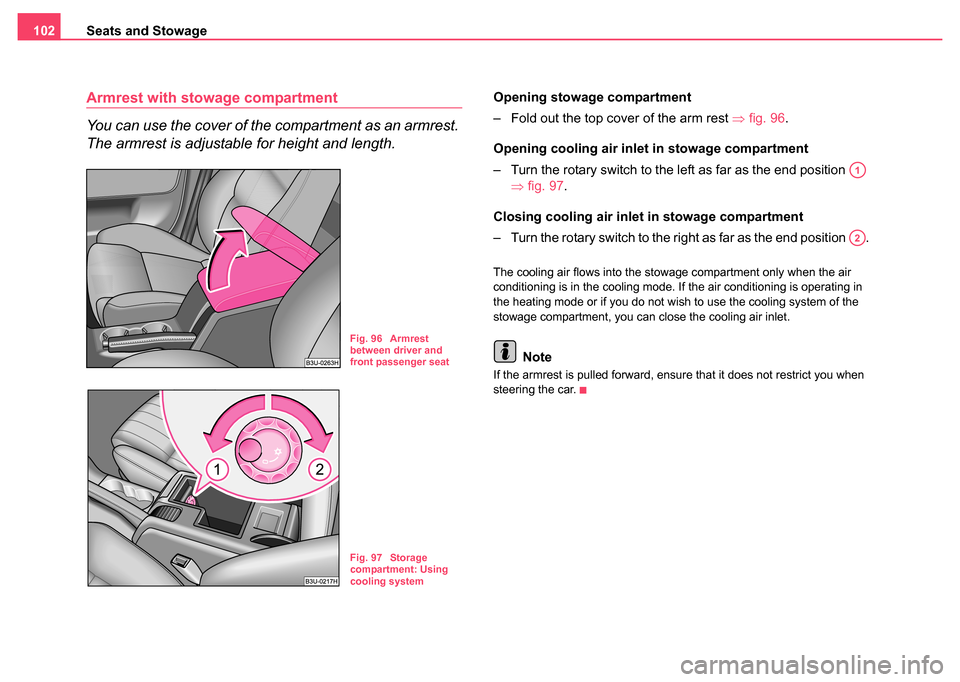
Seats and Stowage
102
Armrest with stow age compartment
You can use the cover of the compartment as an armrest.
The armrest is adjustable for height and length.Opening stowag e compartment
– Fold out the top cover of the arm rest ⇒ fig. 96.
Opening cooling air inlet in stowage compartment
– Turn the rotary switch to the left as far as the end position ⇒fig. 97.
Closing cooling air inlet in stowage compartment
– Turn the rotary switch to the right as far as the end position .
The cooling air flows into the stowage compartment only when the air
conditioning is in the cooling mode. If the air conditioning is operating in
the heating mode or if you do not wish to use the cooling system of the
stowage compartment, you can close the cooling air inlet.
Note
If the armrest is pulled forward, ensure that it does not restrict you when
steering the car.
Fig. 96 Armrest
between driver and
front passenger seat
Fig. 97 Storage
compartment: Using
cooling system
A1
A2
Page 104 of 270

Seats and Stowage103
Using the systemSafetyDriving TipsGeneral MaintenanceBreakdown assistanceTechnical Data
Rear armrest with stowage compartment
– You can fold down the armrest to enhance occupant comfort.
The armrest includes a stowage compartment. You open the compartment
by pressing the button on the front side of the armrest and raising the
cover. A drinks can holder* ⇒page 92 and the operation control for the
electrical passenger seat* ⇒page 76 are located in the armrest.
Clothes hooks
You will find a clothes hook above each of the rear doors.
WARNING
•Ensure that any clothes hanging from the hooks do not impair
your vision to the rear.
•Use the hooks for hanging only light items of clothing and
ensure that there are no heavy or sharp-edged objects in the
pockets.
•Do not use clothes hangers for hanging up items of clothing
otherwise this will interfere with the protection offered by the head
airbag*.
Fig. 98 Armrest of rear
seats:Fig. 99 Area above
rear doors: Clothes
hooks
Page 105 of 270
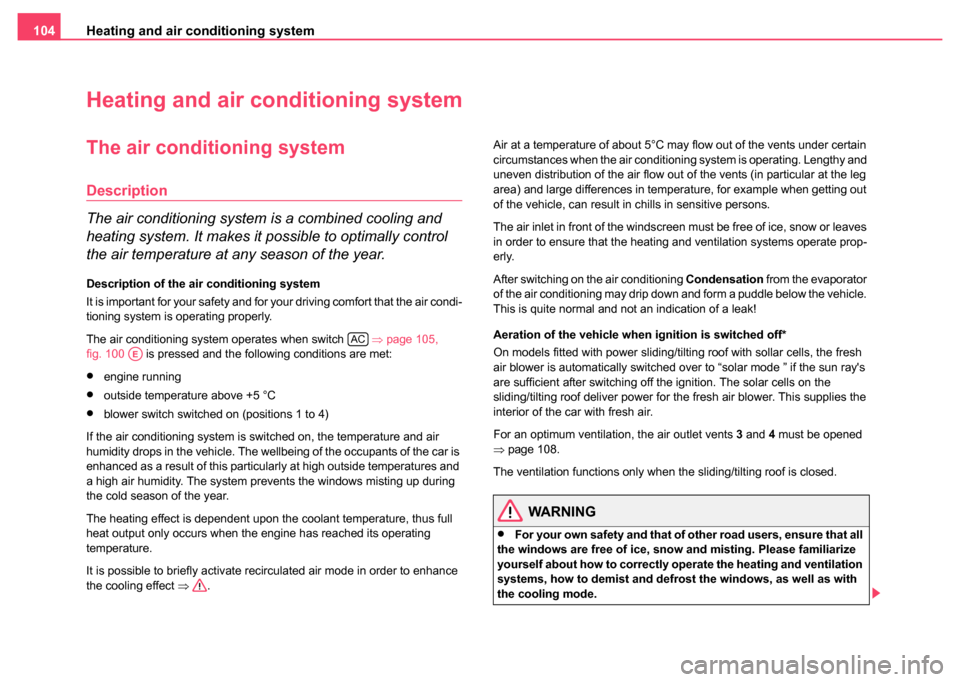
Heating and air conditioning system
104
Heating and air conditioning system
The air conditioning system
Description
The air conditioning system is a combined cooling and
heating system. It makes it possible to optimally control
the air temperature at any season of the year.
Description of the air conditioning system
It is important for your safety and for your driving comfort that the air condi-
tioning system is operating properly.
The air conditioning system operates when switch ⇒page 105,
fig. 100 is pressed and the following conditions are met:
•engine running
•outside temperature above +5 °C
•blower switch switched on (positions 1 to 4)
If the air conditioning system is switched on, the temperature and air
humidity drops in the vehicle. The wellbeing of the occupants of the car is
enhanced as a result of this particularly at high outside temperatures and
a high air humidity. The system prevents the windows misting up during
the cold season of the year.
The heating effect is dependent upon the coolant temperature, thus full
heat output only occurs when the engine has reached its operating
temperature.
It is possible to briefly activate recirculated air mode in order to enhance
the cooling effect ⇒. Air at a temperature of about 5°C may flow out of the vents under certain
circumstances when the air conditioning system is operating. Lengthy and
uneven distribution of the air flow out of the vents (in particular at the leg
area) and large differences in temperature, for example when getting out
of the vehicle, can result in chills in sensitive persons.
The air inlet in front of the windscreen must be free of ice, snow or leaves
in order to ensure that the heating and ventilation systems operate prop-
erly.
After switching on the air conditioning
Condensation from the evaporator
of the air conditioning may drip down and form a puddle below the vehicle.
This is quite normal and not an indication of a leak!
Aeration of the vehicle when ignition is switched off*
On models fitted with power sliding/tilting roof with sollar cells, the fresh
air blower is automatically switched over to “solar mode ” if the sun ray's
are sufficient after switching off the ignition. The solar cells on the
sliding/tilting roof deliver power for the fresh air blower. This supplies the
interior of the car with fresh air.
For an optimum ventilation, the air outlet vents 3 and 4 must be opened
⇒ page 108.
The ventilation functions only when the sliding/tilting roof is closed.
WARNING
•For your own safety and that of other road users, ensure that all
the windows are free of ice, snow and misting. Please familiarize
yourself about how to correctly op erate the heating and ventilation
systems, how to demist and defrost the windows, as well as with
the cooling mode.
ACAE
Page 106 of 270
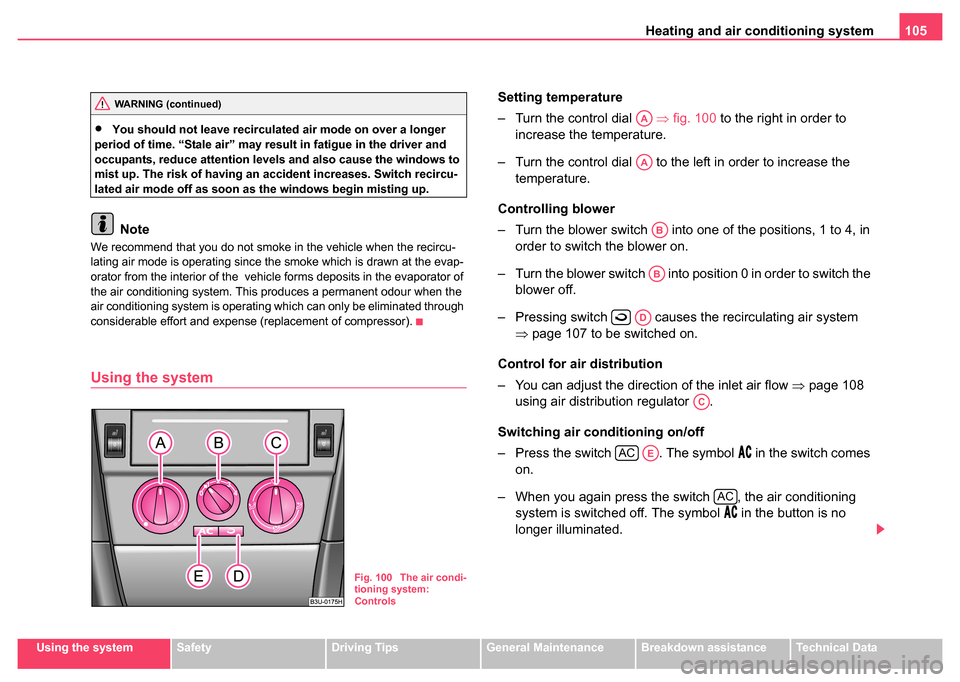
Heating and air conditioning system 105
Using the systemSafetyDriving TipsGeneral MaintenanceBreakdown assistanceTechnical Data
•You should not leave recirculated air mode on over a longer
period of time. “Stale air” may result in fatigue in the driver and
occupants, reduce attention levels and also cause the windows to
mist up. The risk of having an accident increases. Switch recircu-
lated air mode off as soon as the windows begin misting up.
Note
We recommend that you do not smoke in the vehicle when the recircu-
lating air mode is operating since the smoke which is drawn at the evap-
orator from the interior of the vehicle forms deposits in the evaporator of
the air conditioning system. This produces a permanent odour when the
air conditioning system is operating which can only be eliminated through
considerable effort and expense (replacement of compressor).
Using the system
Setting temperature
– Turn the control dial ⇒fig. 100 to the right in order to
increase the temperature.
– Turn the control dial to the left in order to increase the temperature.
Controlling blower
– Turn the blower switch into one of the positions, 1 to 4, in order to switch the blower on.
– Turn the blower switch into position 0 in order to switch the blower off.
– Pressing switch causes the recirculating air system ⇒page 107 to be switched on.
Control for air distribution
– You can adjust the direction of the inlet air flow ⇒page 108
using air distribution regulator .
Switching air conditioning on/off
– Press the switch . The symbol
in the switch comes
on.
– When you again press the switch , the air conditioning system is switched off. The symbol
in the button is no
longer illuminated.
WARNING (continued)
Fig. 100 The air condi-
tioning system:
Controls
AA
AA
AB
AB
AD
AC
ACAE
AC
Page 107 of 270
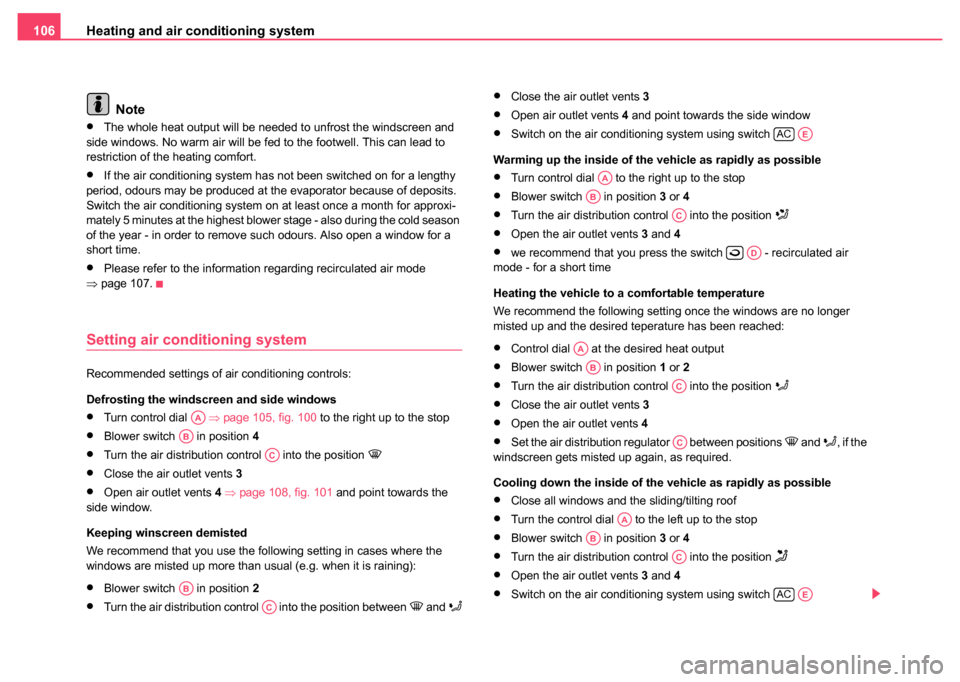
Heating and air conditioning system
106
Note
•The whole heat output will be needed to unfrost the windscreen and
side windows. No warm air will be fed to the footwell. This can lead to
restriction of the heating comfort.
•If the air conditioning system has not been switched on for a lengthy
period, odours may be produced at the evaporator because of deposits.
Switch the air conditioning system on at least once a month for approxi-
mately 5 minutes at the highest blower stage - also during the cold season
of the year - in order to remove such odours. Also open a window for a
short time.
•Please refer to the information regarding recirculated air mode
⇒ page 107.
Setting air conditioning system
Recommended settings of air conditioning controls:
Defrosting the windscreen and side windows
•Turn control dial ⇒page 105, fig. 100 to the right up to the stop
•Blower switch in position 4
•Turn the air distribution control into the position
•Close the air outlet vents 3
•Open air outlet vents 4 ⇒ page 108, fig. 101 and point towards the
side window.
Keeping winscreen demisted
We recommend that you use the following setting in cases where the
windows are misted up more than usual (e.g. when it is raining):
•Blower switch in position 2
•Turn the air distribution control into the position between and
•Close the air outlet vents 3
•Open air outlet vents 4 and point towards the side window
•Switch on the air conditioning system using switch
Warming up the inside of the ve hicle as rapidly as possible
•Turn control dial to the right up to the stop
•Blower switch in position 3 or 4
•Turn the air distribution control into the position
•Open the air outlet vents 3 and 4
•we recommend that you press the switch - recirculated air
mode - for a short time
Heating the vehicle to a comfortable temperature
We recommend the following setting once the windows are no longer
misted up and the desired teperature has been reached:
•Control dial at the desired heat output
•Blower switch in position 1 or 2
•Turn the air distribution control into the position
•Close the air outlet vents 3
•Open the air outlet vents 4
•Set the air distribution regulator between positions and , if the
windscreen gets misted up again, as required.
Cooling down the inside of the vehicle as rapidly as possible
•Close all windows and the sliding/tilting roof
•Turn the control dial to the left up to the stop
•Blower switch in position 3 or 4
•Turn the air distribution control into the position
•Open the air outlet vents 3 and 4
•Switch on the air conditioning system using switch
AA
AB
AC
AB
AC
ACAE
AA
AB
AC
AD
AA
AB
AC
AC
AA
AB
AC
ACAE
Page 108 of 270
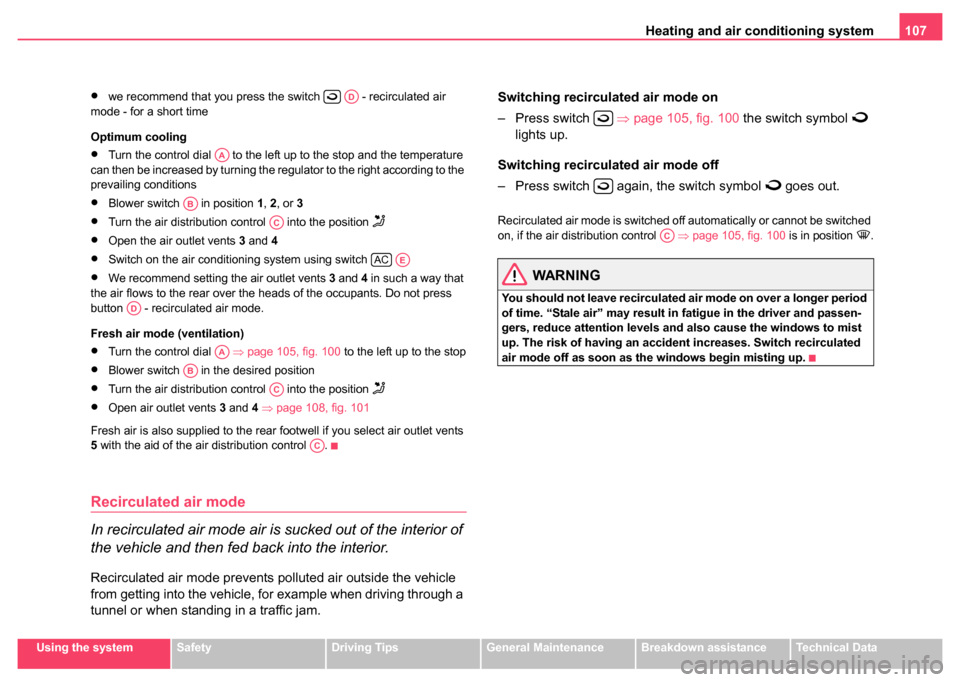
Heating and air conditioning system 107
Using the systemSafetyDriving TipsGeneral MaintenanceBreakdown assistanceTechnical Data
•we recommend that you press the switch - recirculated air
mode - for a short time
Optimum cooling
•Turn the control dial to the left up to the stop and the temperature
can then be increased by turning the regulator to the right according to the
prevailing conditions
•Blower switch in position 1, 2 , or 3
•Turn the air distribution control into the position
•Open the air outlet vents 3 and 4
•Switch on the air conditioning system using switch
•We recommend setting the air outlet vents 3 and 4 in such a way that
the air flows to the rear over the heads of the occupants. Do not press
button - recirculated air mode.
Fresh air mode (ventilation)
•Turn the control dial ⇒page 105, fig. 100 to the left up to the stop
•Blower switch in the desired position
•Turn the air distribution control into the position
•Open air outlet vents 3 and 4 ⇒ page 108, fig. 101
Fresh air is also supplied to the rear footwell if you select air outlet vents
5 with the aid of the air distribution control .
Recirculated air mode
In recirculated air mode air is sucked out of the interior of
the vehicle and then fed back into the interior.
Recirculated air mode prevents polluted air outside the vehicle
from getting into the vehicle, for example when driving through a
tunnel or when standing in a traffic jam. Switching recircul
ated air mode on
– Press switch ⇒page 105, fig. 100 the switch symbol
lights up.
Switching recirculated air mode off
– Press switch again, the switch symbol
goes out.
Recirculated air mode is switched off automatically or cannot be switched
on, if the air distribution control ⇒page 105, fig. 100 is in position .
WARNING
You should not leave recirculated air mode on over a longer period
of time. “Stale air” may result in fatigue in the driver and passen-
gers, reduce attention levels and also cause the windows to mist
up. The risk of having an accident increases. Switch recirculated
air mode off as soon as the windows begin misting up.
AD
AA
AB
AC
ACAE
AD
AA
AB
AC
AC
AC
Page 109 of 270
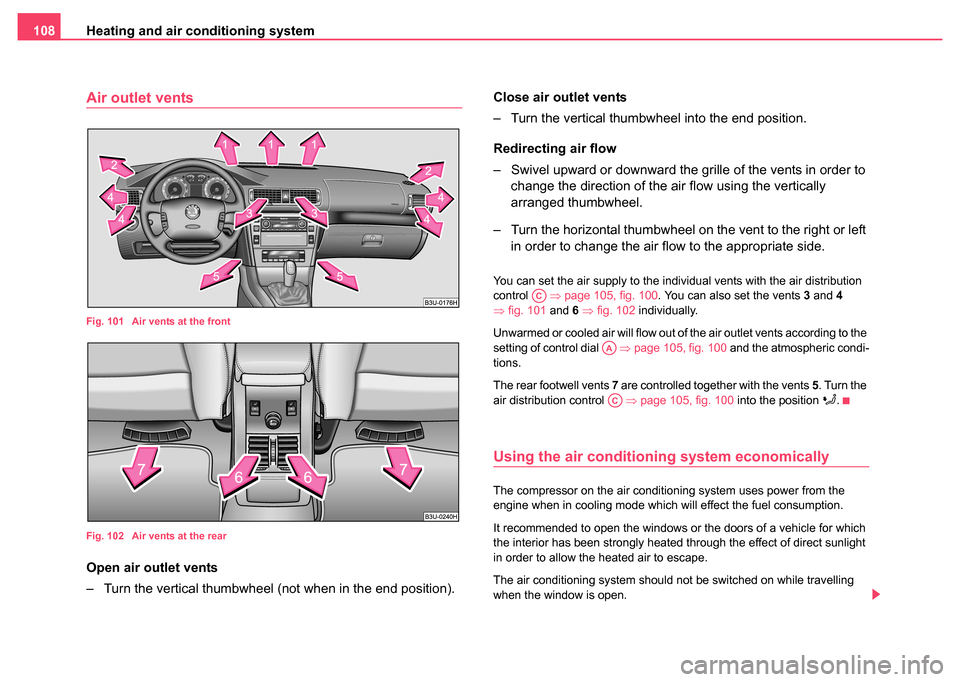
Heating and air conditioning system
108
Air outlet vents
Fig. 101 Air vents at the front
Fig. 102 Air vents at the rear
Open air outlet vents
– Turn the vertical thumbwheel (not when in the end position). Close air outlet vents
– Turn the vertical thumbwheel into the end position.
Redirecting air flow
– Swivel upward or downward the gr
ille of the vents in order to
change the direction of the air flow using the vertically
arranged thumbwheel.
– Turn the horizontal thumbwheel on the vent to the right or left in order to change the air flow to the appropriate side.
You can set the air supply to the individual vents with the air distribution
control ⇒page 105, fig. 100 . You can also set the vents 3 and 4
⇒ fig. 101 and 6 ⇒ fig. 102 individually.
Unwarmed or cooled air will flow out of the air outlet vents according to the
setting of control dial ⇒ page 105, fig. 100 and the atmospheric condi-
tions.
The rear footwell vents 7 are controlled together with the vents 5. Turn the
air distribution control ⇒page 105, fig. 100 into the position
.
Using the air conditioning system economically
The compressor on the air conditioning system uses power from the
engine when in cooling mode which will effect the fuel consumption.
It recommended to open the windows or the doors of a vehicle for which
the interior has been strongly heated through the effect of direct sunlight
in order to allow the heated air to escape.
The air conditioning system should not be switched on while travelling
when the window is open.
AC
AA
AC
Page 110 of 270
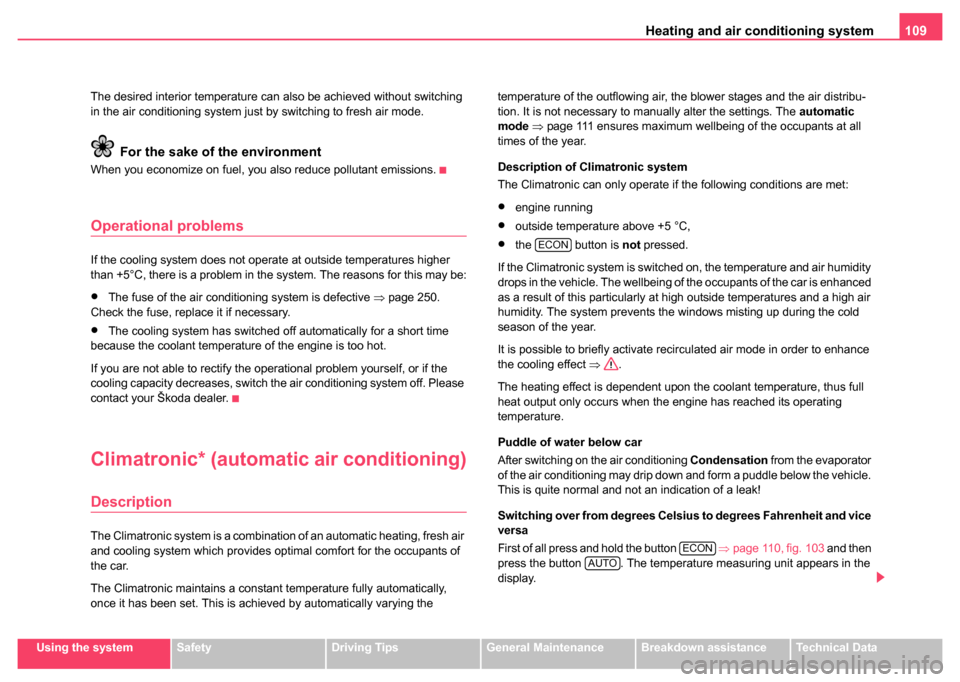
Heating and air conditioning system 109
Using the systemSafetyDriving TipsGeneral MaintenanceBreakdown assistanceTechnical Data
The desired interior temperature can also be achieved without switching
in the air conditioning system just by switching to fresh air mode.
For the sake of
the environment
When you economize on fuel, you also reduce pollutant emissions.
Operational problems
If the cooling system does not operate at outside temperatures higher
than +5°C, there is a problem in the system. The reasons for this may be:
•The fuse of the air conditioning system is defective ⇒page 250.
Check the fuse, replace it if necessary.
•The cooling system has switched off automatically for a short time
because the coolant temperature of the engine is too hot.
If you are not able to rectify the operational problem yourself, or if the
cooling capacity decreases, switch the air conditioning system off. Please
contact your Škoda dealer.
Climatronic* (automatic air conditioning)
Description
The Climatronic system is a combination of an automatic heating, fresh air
and cooling system which provides optimal comfort for the occupants of
the car.
The Climatronic maintains a constant temperature fully automatically,
once it has been set. This is achieved by automatically varying the temperature of the outflowing air, the blower stages and the air distribu-
tion. It is not necessary to manually alter the settings. The
automatic
mode ⇒ page 111 ensures maximum wellbeing of the occupants at all
times of the year.
Description of Climatronic system
The Climatronic can only operate if the following conditions are met:
•engine running
•outside temperature above +5 °C,
•the button is not pressed.
If the Climatronic system is switched on, the temperature and air humidity
drops in the vehicle. The wellbeing of the occupants of the car is enhanced
as a result of this particularly at high outside temperatures and a high air
humidity. The system prevents the windows misting up during the cold
season of the year.
It is possible to briefly activate recirculated air mode in order to enhance
the cooling effect ⇒.
The heating effect is dependent upon the coolant temperature, thus full
heat output only occurs when the engine has reached its operating
temperature.
Puddle of water below car
After switching on the air conditioning Condensation from the evaporator
of the air conditioning may drip down and form a puddle below the vehicle.
This is quite normal and not an indication of a leak!
Switching over from degrees Celsius to degrees Fahrenheit and vice
versa
First of all press and hold the button ⇒ page 110, fig. 103 and then
press the button . The temperature measuring unit appears in the
display.ECON
ECONAUTO